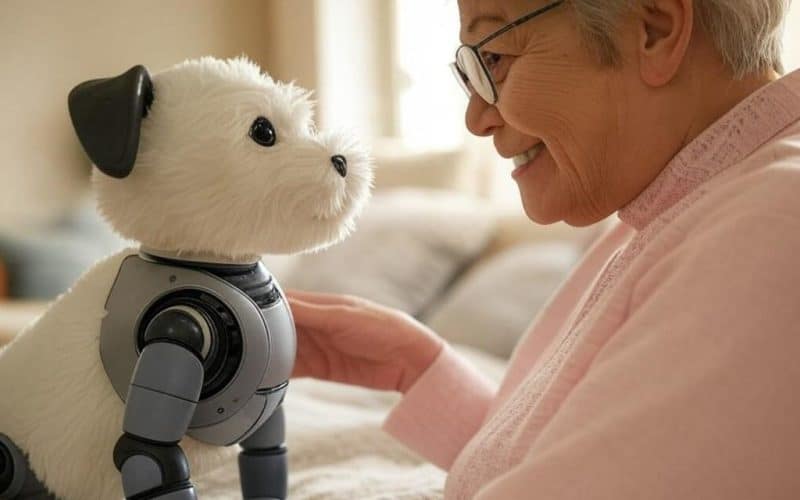
Australian Tom Stevens faced a heart-wrenching decision: removing his mother Nancy’s beloved dog due to her advancing Alzheimer’s disease. This loss deepened her loneliness and depression. Determined to find a solution, Tom founded Tombot and developed the robotic pet Jennie, a lifelike robotic dog designed to provide companionship for individuals with dementia.
It’s just one of many examples where robotic pets are introduced as valuable companions for individuals with dementia, offering emotional support and cognitive stimulation without the challenges of traditional pet ownership.
In this article we dive into what benefits these robotic pets can have for people suffering dementia and what the future will bring with the introduction of AI.
Why Specifically Using Robotic Pets With People Suffering From Dementia?
Individuals with dementia often experience loneliness, anxiety, and a decline in cognitive function. Pets can provide companionship, emotional support, and a sense of purpose, which are beneficial in addressing these challenges. Interacting with animals has been shown to reduce stress and improve mood in dementia patients.
🐶 The makers of Jennie, a robotic puppy, hope it will provide companionship for those who are unable to look after a real animal on their own pic.twitter.com/PXAWPwWVE3
— Reuters (@Reuters) January 9, 2025
However, traditional pet ownership presents challenges for those with dementia. Caring for a pet requires consistent feeding, grooming, and medical attention, tasks that may become overwhelming as cognitive abilities decline. Additionally, concerns about the safety of both the individual and the pet arise, especially if the person forgets to care for the animal or becomes confused.
Robotic pets offer a practical solution by providing the benefits of companionship and interaction without the responsibilities associated with live animals. These lifelike robots can mimic animal behaviors, offering comfort and engagement to individuals with dementia.
Benefits Of Using Robotic Pets
Interacting with robotic pets can reduce anxiety and agitation in dementia patients. These lifelike companions provide comfort, alleviate loneliness, and promote social engagement. For instance, the Paro Therapeutic Robot, modeled after a baby harp seal, responds to touch and sound, exhibiting behaviors like moving its head and making seal-like noises. It’s used in therapeutic settings to reduce stress and improve mood among dementia patients.
Unlike live animals, robotic pets do not require feeding or exercise, making them suitable for individuals who may struggle with the responsibilities of pet care. They are also hypoallergenic, eliminating concerns for those with allergies. In short these pets are practical and low-maintenance companions.
And, important, they also offer consistent companionship without the unpredictability of live animals, which can be reassuring for dementia patients.
There are 3 main benefits we identified:
Emotional Support and Companionship
Robotic pets, such as Tombot’s lifelike golden retriever puppy, are designed to function as lapdogs, responding to pats and words from their owners. They provide comfort and stimulation, which is particularly beneficial for dementia patients whose worlds are shrinking.
Reduction of Agitation and Anxiety
Interacting with robotic pets can lead to decreased anxiety and behavioral issues in dementia patients. Studies have shown that robotic pets provide comfort and alleviate loneliness in those who live alone, have fewer social connections, and live less active lifestyles.
Cognitive Stimulation and Social Engagement
Robotic pets encourage social interaction and cognitive engagement. For instance, the robot dog “Perrete” has been used in therapy sessions to stimulate cognitive functions, promote socialization, and improve the mood of residents with dementia.
Several robotic pets have been designed specifically for therapeutic use:
- Tombot’s Jennie: A lifelike golden retriever puppy that responds to touch and voice commands, providing comfort without the responsibilities of a live pet. And… equipped with AI.
- Joy for All Companion Pets: Interactive cats and dogs that feature soft fur, realistic sounds, and responsive movements, reacting to petting and hugging to offer a soothing presence.
- Paro Therapeutic Robot: Modeled after a baby harp seal, Paro responds to touch and sound, exhibiting behaviors like moving its head and making seal-like noises, used in therapeutic settings to reduce stress and improve mood among dementia patients.
- Perrete: A Spanish-developed robotic dog designed to assist individuals with Alzheimer’s, interacting through movements and sounds to aid in cognitive stimulation and emotional well-being.
Robotic Pets Enhanced With AI
We mentioned it in the previous section, but bit by bit we also see artificial intelligence (AI) being integrated into robotic pets. This enhances their ability to support individuals with dementia by enabling more personalized and responsive interactions.
Here are some AI-enhanced robotic companions, pets and non-pets:
Tombot’s Jennie: Jennie is a lifelike robotic dog designed to provide companionship for individuals with dementia. Equipped with advanced AI, Jennie responds to touch and voice commands, exhibiting behaviors such as wagging her tail, moving her head, and barking. This responsiveness helps in reducing anxiety and providing comfort to users.
Paro Therapeutic Robot: Paro is a robotic baby harp seal developed for therapeutic purposes. It utilizes AI to recognize light, sound, temperature, and touch, allowing it to respond to stimuli by moving its head and legs, and making sounds. Paro can learn to behave in a way that the user prefers, providing a personalized interaction that can improve mood and reduce stress in dementia patients.
Ryan Companionbot: Ryan is a socially assistive robot designed to provide companionship for older adults with depression and dementia. It employs AI to interpret and respond to users’ emotions through facial expressions and spoken language. Ryan engages users in conversations, cognitive games, and reminiscence activities, aiming to improve their quality of life.
Hyodol: Hyodol is an advanced care robot designed to support the elderly by reminding them to take their medications and monitoring their movements. It can detect and respond to the emotional states of its users, providing personalized care. Hyodol’s AI capabilities enable it to interact naturally with users, enhancing their well-being.
Artificial intelligence (AI) Will Be The Future
Advancements in artificial intelligence (AI) promise to further enhance the capabilities of robotic companions for individuals with dementia. We will in the future have AI Companions, AI enables these robotic pets to learn and adapt to the unique preferences and behaviors of their users, providing personalized interactions that can significantly improve emotional well-being and cognitive engagement.
For instance, AI-driven robots like Samsung’s “Ballie” are designed to learn and evolve, offering personalized experiences such as monitoring pets and managing smart appliances, reflecting a broader AI vision to enhance daily life.
Moreover, AI integration allows for the development of robots capable of proactive interactions. The ElliQ companion robot, for example, not only engages in conversations but also sends health updates to caregivers, demonstrating the potential of AI to support both individuals with dementia and their support networks.
In addition, AI advancements are leading to the creation of more lifelike and responsive robotic pets. At CES, several innovative gadgets were showcased, including lifelike robotic dogs aimed at dementia care, which mimic real pet behaviors to provide comfort and companionship.
These developments suggest a future where AI-powered robotic companions become increasingly effective in enhancing the quality of life for individuals with dementia, offering tailored support that evolves with the user’s needs.
